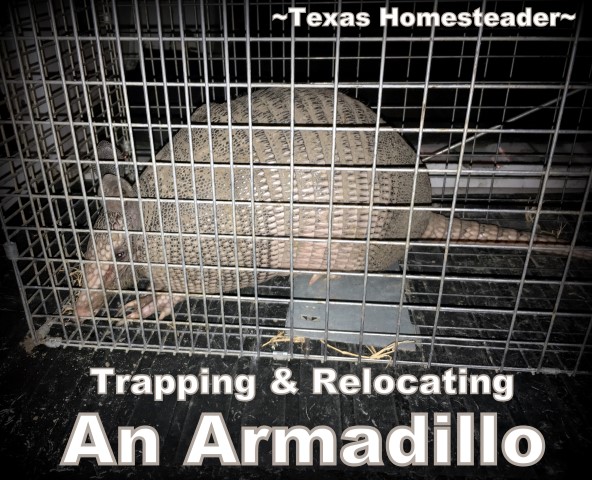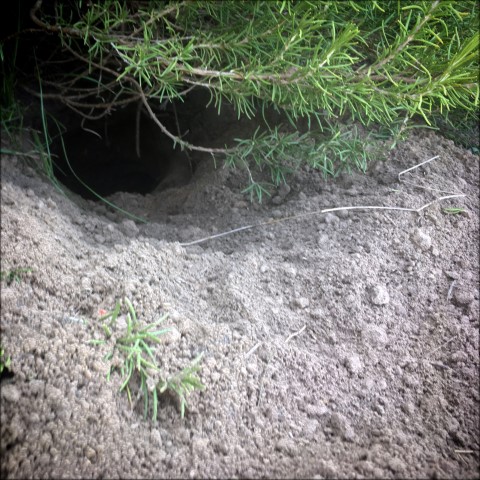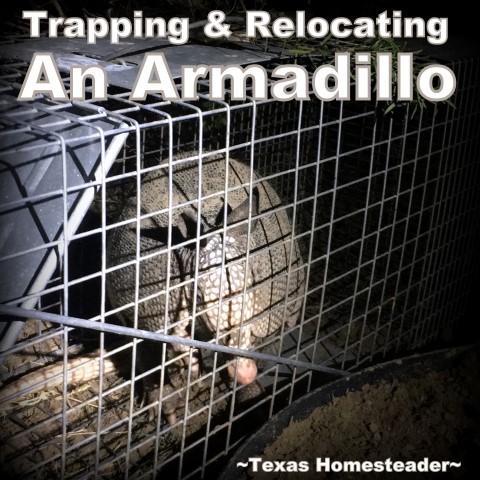by Texas Homesteader ~
We had an armadillo digging deep burrow holes in our yard. We didn’t want to kill it but instead to trap and relocate it. But it’s hard to trap an armadillo because they’re not really attracted to bait. Come see what worked for us.
(Note: Some links in this post will take you to other related articles for further information. But links preceded with * are affiliate links. If you click and buy something I could receive a tiny commission.)
What Animal Is Digging Holes In The Yard?
One morning we found that an animal has burrowed beneath the rosemary plant by our back porch.
A wide and deep burrow has been dug and lots of dirt has been kicked up into the rock border of our porch and the burrow is obviously into the roots of my beloved rosemary plant.
What a mess! Looks like it may be an armadillo tunnel.
Now before I go any further, know that I’m simply sharing what we did to remove a pest that was encroaching upon our space. Our property was being damaged, plus we don’t want to risk a tussle with our mini Schnauzer Bailey & a potentially dangerous animal.
But we don’t like to kill a critter just for being what it is unless it’s venomous.
No, we’re not animal-trapping experts and we certainly don’t know it all. But here’s what we did to successfully trap and remove the armadillo:
A Plan To Trap An Armadillo
We decided a *Live Trap will be set to capture and relocate this animal because it simply cannot stay!
Not only is it tearing up our landscaping but we don’t want to chance our mini-schauzer coming into contact with something that could harm her.
Due to the size of the burrow, we’re trapping based on the premise that we’re dealing with an armadillo.
The mystery critter had previously dug lightly around our rain barrel. We’d raked the area smooth to repair the damage, but it came back the next day & dug the same area, this time more deeply.
We repaired the damage again blocked it off with a large stone and thought that was the end of that.
But the next day we found a deep burrow beneath our huge rosemary plant next to our back porch. It was about 2 ft deep and 10″ wide. I wonder if it’s a female & she’s looking for a place to have babies?
Upon close inspection we found the burrow was closed-ended & empty. RancherMan’s research showed this was probably just one of several ‘escape burrows’ that is typical for an armadillo.
Armadillos Are Hard To Trap
We don’t automatically turn to dispatching a critter unless it’s venomous or when other methods don’t work. So we started researching the best ways to trap an armadillo.
But we’re reading that armadillos are notoriously hard to capture in a trap. Any bait you use will not attract them because they root in the ground for their food instead.
So instead of attracting an armadillo, the bait in your trap could attract other pests such as raccoons, possums, etc. That certainly defeats your purpose!
Working With An Armadillo’s Natural Tendencies
So we set the live box trap (with no bait at all) right at the burrow entrance hoping she would come back to hide in the borrow and go into the trap instead.
The trap was placed right on top of the hole, the burrow opening aligned with the opening of the trap. Hopefully she’ll go into the trap not for food, but simply in her effort to enter the burrow.
Since she’ll be coming around after dark and we don’t want to stand outside watching for hours on end, we also placed a small *motion-activated sensor by the trap so we’d be alerted if/when she arrived.
We got lucky.
When we heard the alarm go off around 10:30 that night we went out to inspect. The trap was empty but it was too dark to see very well to survey the surroundings closely.
So we came inside to get a flashlight & went back out to inspect more closely. In that short time apparently she went to hide in the escape burrow & went into the trap instead, just as we’d hoped!
Isn’t she cute?? I’ve always loved the look of armadillos. They almost look prehistoric with their body armor.
We relocated her to the farthest back section of the pasture so she can do her armadillo thaaaaang without destroying our landscaping.
Will A Relocated Armadillo Return?
It’s said to assure they don’t come back, you need to relocate an armadillo over 5 miles away.
So even though this one was released in the farthest-away section of our 100-acre homestead pasture, she could technically navigate back to the house if she wanted.
But as long as there’s food, water and shelter there, I’m guessing that she’ll be happy right where she is.
Not Necessarily The Same Animal Returning
Many say that you must kill the armadillo because it WILL return unless you take it 5 miles away. But as I mentioned at the beginning, we don’t dispatch unless other methods of relocation are unsuccessful.
We’ve since had other armadillos that required relocation. We’ve trapped and relocated them to the back of our 100-acre homestead only to have the trap filled with an armadillo the next day, and the next.
So assuming it was the same armadillo coming back, we felt we had no alternative than to dispatch it. And we did. But the next night, the trap was tripped again with yet another armadillo!
So my guess is that sometimes there are several in a group of armadillos that might come to the burrow. Maybe they’re attracted by scent or something? I don’t know.
But it proves to me that just because the trap might be filled even after relocating an armadillo doesn’t mean it’s the same armadillo coming back. Sometimes you’ll need to relocate several to finally move the small group.
Trapping and Relocating Armadillos Was Successful
My experience is that when we relocate critters as far away as we can, even though it’s not 5 miles away, they find food & shelter abundant where we move them.
Then unless there’s a reason for them to trek all the way back to the original location they can just continue on with their lives.
If she (or another like her) encroaches on our space again we’ll trap them again. But we realize how important different critters are to the ecosystem. So our preference is always relocation instead of killing a critter.
This live trap has been helpful so many times. So far the relocations we’ve had to do with armadillos, possums, snakes and raccoons have been few & far between.
Sometimes we have to trap the whole family of critters & remove them one by one, but typically that’s the end of it.
So for now we’ll chalk our armadillo relocation up as a SUCCESS!
~TxH~
Other Wildlife Posts
- Trapping Wild Hogs
- Wild Hogs: Making The Best Of A Bad Situation
- Wild Hog Damage
- Trapping & Relocating An Armadillo
- Adding Temporary Protection For Wild Rabbit’s Nest
- Keeping Wild Birds From Eating Your Chicken’s Feed
- How To Keep Birds (and their POOP) Off Your Railings
- Itchy Chiggers – Separating Relief Fact From Fallacy
- How To Safely Catch & Relocate A Beneficial Snake
NE Texas Native Trees & Plants
C’mon by & sit a spell! Come hang out at our Facebook Page . It’s like sitting in a front porch rocker with a glass of cold iced tea. There are lots of good folks sharing! And you can also follow along on Pinterest, Twitter & Instagram
If you’d like to receive an email when a new blog post goes live,
subscribe to our Blog!







31 years ago we moved onto this place. Early on we were on a swing watching the sun set and an armadillo ran by right in front of our feet. Daughter (maybe 6 or 7) asked if it was a dinosaur. LOL. Before that at the old place she had asked her Mom if a jackrabbit was a kangaroo! Innocence. Regards.
A dinosaur – Lol. I get it, Ken! They really *do* look like dinosaurs. 😀 ~TxH~
I don’t have an armadillo but I have an equally pesky woodchuck. Those critters can climb any fence (or tree) and slither and squirm their way through well secured netting. At least I thought it was well secured. A good perimeter of a granular critter repellant was added as an additional deterrent. I came out to the garden earlier this week only to see the d*** thing retrace his steps out of the garden bed after he had eaten 6 full for harvest broccoli plants and a start on the cabbage. He would have finished off the cabbage, too if I hadn’t showed up. Hope he had a horrible belly ache. Now to figure out something new to protect my garden. I live in a no-fence subdivision so my options other than as “invisible as possible” rabbit or chicken wire around the beds are somewhat limited. I thought I had the problem solved because he hadn’t bothered anything all summer. Deer are another story …..
Ugh, I’m so glad we don’t deal with many deer here Linda. (RancherMan feels oh-so-differently! LOL) Hope you get to salvage your garden. ~TxH~
I would echo ColleenB’s sentiments re: trapping and relocating. It always feels like we are the interlopers in this world and everything else is just doing it’s job of getting on w/ life. We had a cougar in our driveway a couple of weeks ago. They’re pretty scary, very BIG cats. It did just mosey on into the brush and went on its way.
Wowser – I’ve never seen a cougar here Candace (thank goodness!!) They’re beautiful… from a distance! LOL ~TxH~
Good for you in trapping and relocating the creature. Armadillos are good at digging some serious holes in ones yard and you are so right, they can also do a lot of damage.
Knock on wood, but that is one thing we never had a problem with. Now I have seen dead armadillos along side of the road here that have been hit by vehicles.
Now possums we have seen here but they aren’t meat eaters and have seen a skunk once but that’s about all we have had here; thank goodness.
A snake once in awhile but no dangerous snakes. My daughter and her husband did have and killed a copperhead snake that was in their fenced in dog area
We’re typically able to trap & relocate. And that’s always our preference, I love having the variety of wildlife that we do here. There are times when we’ve had to dispatch an animal or snake but it’s actually pretty rare. ~TxH~